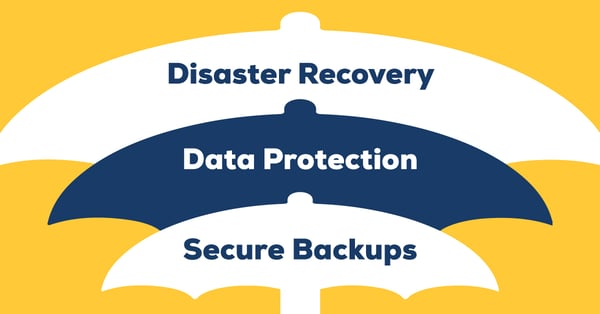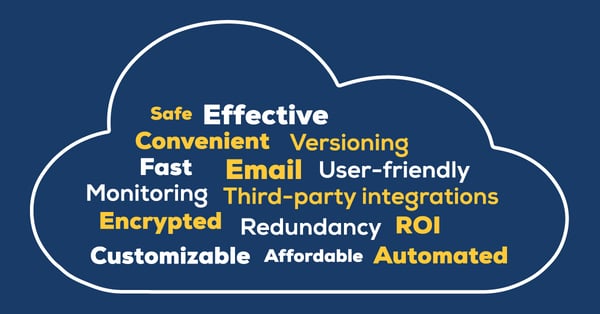Do you feel lucky? If your business is located in the U.S., you should. In 2022, the incident rate for ransomware attacks in the US is just 7% compared to the worldwide average of 37%.
Of course, ransomware attacks are just one of the ways that your business could lose its data. Human error, natural disasters, malicious deletion, and hardware failure can be just as catastrophic unless you have a recent, secure backup solution that you can use to quickly recover.
So…do you? If you’re not sure, or you haven’t rethought your backup strategy in the past few years, read on…
Data Protection and Disaster Recovery

Data protection is just one component of disaster recovery, and secure backups are just one way of protecting your data. Just for clarity, let’s explore these terms. Feel free to skip ahead if you’re well-versed in this subject matter!
Data Protection
Data protection, which is also known as backup and restore (BR) refers to the process of protecting your business’s data from loss. Cloud, tape, and disk backups are one component of robust data protection, which should also include encryption, network security, and physical security solutions.
Disaster Recovery
Disaster recovery refers to the restoration of applications, services, and data after a human-caused or natural disaster.
Disaster Recovery Plan
An effective disaster recovery plan (DRP) serves as a comprehensive guide for your staff to recover your IT infrastructure, including your data.
How Often Should You Back Up Your Data?
We recommend scheduling a full data backup at least once a week. Some businesses should also consider additional incremental backups during the week.
Pro tip: It’s often easiest to schedule your backups during off-hours or over the weekends to minimize any inconvenience to your staff or your customers.
What You Should Consider to Effectively Protect and Recover Data

Not all backup solutions are the same, and no single solution is 100% safe. Here is a list of things you should keep in mind to make sure your business will be able to recover from a significant data loss in a timely manner.
1. Recovery Time/Ease
Downtime can be incredibly costly. An offsite tape backup isn’t vulnerable to a cyberattack, but restoring your systems from tape is a manual process, and it will take longer. That doesn’t mean you shouldn’t consider using tape as one potential solution — perhaps a backup to the backup — but it probably won’t be your first choice for a speedy recovery.
2. Vulnerabilities
Again, no method is 100% safe. Offsite, offline backups can be lost, damaged, or stolen, but they aren’t vulnerable to a cyberattack. As cybercriminals are targeting online backups 93% of the time before launching a ransomware attack, it’s in your best interests to balance the vulnerabilities of your backup solutions.
Cybercriminals are also targeting backup servers for the purposes of extortion — threatening to release sensitive data publicly or on the dark web unless you pay up. So make sure your backup solution actually makes your data safer.
3. Capabilities
Some backup solutions offer additional convenience and will help you meet any compliance requirements. If one of your backup solutions is stored in the cloud — which we recommend — you might consider a cloud provider that can offer you some or all of these capabilities:- Automated backup scheduling
- Data retention and versioning
- Redundancy
- Encryption and secure access controls
- A user-friendly interface
- Fast recovery
- Cross-platform compatibility
- Reporting and monitoring
- Data deduplication
- Archiving
- Third-party integrations
- Testing and verification
- Customization
4. Value/ROI
Fortunately, cloud backup solutions tend to be affordable, efficient, and highly secure. But always remember to look past the price tag and consider the potential costs of data loss, downtime, and data recovery efforts. A “cheaper” backup solution that doesn’t actually protect your data could end up costing you dearly.
Finding the Right Backup Solutions

As a managed services provider, finding the right backup solutions is directly tied to our ability to serve our clients. So we were able to take our sweet time in finding a cloud provider we can wholeheartedly recommend.
We’ve chosen to partner with Barracuda because it combines rapid recovery capabilities and ease of use with robust cybersecurity and advanced features — all for an affordable price. Here are our top 10 reasons why our backup experts love it:
- It can be quickly deployed in under an hour
- It offers rapid recovery of on-premises virtual, physical, and Microsoft applications
- It can serve as an all-in-one solution combining storage, software, cloud storage, and cloud-based management
- It offers unlimited cloud storage for disaster recovery
- It can be installed and configured in around 30 minutes
- You can manage it from anywhere
- It’s built on a hardened Linux operating system
- Your data is only readable if it’s accessed through Barracuda
- Your data will be encrypted in transit and at rest
- Barracuda requires multifactor authentication to access your data
Of course, these are just our favorites. Find a full list of features on Barracuda’s website, along with a helpful FAQ page.
Getting More From Your Barracuda Backup Solution
For starters, because we’ve entered a strategic partnership with Barracuda, we can not only offer you world-class support but also insider pricing. However, your backup solution is only one component of your overall data protection and disaster recovery strategy. If you also need additional help with any of these, our experts can assist you in developing a comprehensive disaster recovery plan and testing it to make sure it’ll be effective when it matters most.
 Yes, we also help clients recover as much data as possible after a cyberattack, but we’d much rather help you waste a cybercriminal’s time and make sure they get away with absolutely nothing. Cybercriminals are like most other criminals in that they’re out to make a quick profit without much effort. The more businesses that make it very, very hard for them to do that, the better it is for all of us.
Yes, we also help clients recover as much data as possible after a cyberattack, but we’d much rather help you waste a cybercriminal’s time and make sure they get away with absolutely nothing. Cybercriminals are like most other criminals in that they’re out to make a quick profit without much effort. The more businesses that make it very, very hard for them to do that, the better it is for all of us.
On that note, if you’d like some quick tips on designing a comprehensive disaster recovery plan, Barracuda has designed a free, 8-question checklist to help inform your process. Click the link below to download it!